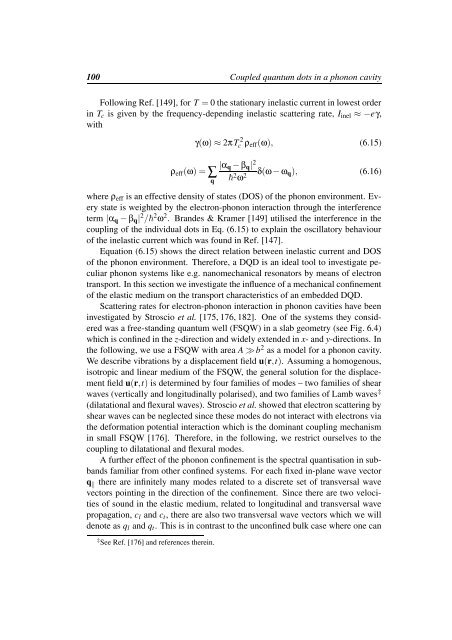Spin-orbit coupling and electron-phonon scattering - Fachbereich ...
Spin-orbit coupling and electron-phonon scattering - Fachbereich ...
Spin-orbit coupling and electron-phonon scattering - Fachbereich ...
Create successful ePaper yourself
Turn your PDF publications into a flip-book with our unique Google optimized e-Paper software.
100 Coupled quantum dots in a <strong>phonon</strong> cavity<br />
Following Ref. [149], for T = 0 the stationary inelastic current in lowest order<br />
in T c is given by the frequency-depending inelastic <strong>scattering</strong> rate, I inel ≈ −eγ,<br />
with<br />
ρ eff (ω) = ∑<br />
q<br />
γ(ω) ≈ 2πT 2<br />
c ρ eff (ω), (6.15)<br />
|α q − β q | 2<br />
2 ω 2 δ(ω − ω q ), (6.16)<br />
where ρ eff is an effective density of states (DOS) of the <strong>phonon</strong> environment. Every<br />
state is weighted by the <strong>electron</strong>-<strong>phonon</strong> interaction through the interference<br />
term |α q − β q | 2 / 2 ω 2 . Br<strong>and</strong>es & Kramer [149] utilised the interference in the<br />
<strong>coupling</strong> of the individual dots in Eq. (6.15) to explain the oscillatory behaviour<br />
of the inelastic current which was found in Ref. [147].<br />
Equation (6.15) shows the direct relation between inelastic current <strong>and</strong> DOS<br />
of the <strong>phonon</strong> environment. Therefore, a DQD is an ideal tool to investigate peculiar<br />
<strong>phonon</strong> systems like e.g. nanomechanical resonators by means of <strong>electron</strong><br />
transport. In this section we investigate the influence of a mechanical confinement<br />
of the elastic medium on the transport characteristics of an embedded DQD.<br />
Scattering rates for <strong>electron</strong>-<strong>phonon</strong> interaction in <strong>phonon</strong> cavities have been<br />
investigated by Stroscio et al. [175, 176, 182]. One of the systems they considered<br />
was a free-st<strong>and</strong>ing quantum well (FSQW) in a slab geometry (see Fig. 6.4)<br />
which is confined in the z-direction <strong>and</strong> widely extended in x- <strong>and</strong> y-directions. In<br />
the following, we use a FSQW with area A ≫b 2 as a model for a <strong>phonon</strong> cavity.<br />
We describe vibrations by a displacement field u(r,t). Assuming a homogenous,<br />
isotropic <strong>and</strong> linear medium of the FSQW, the general solution for the displacement<br />
field u(r,t) is determined by four families of modes – two families of shear<br />
waves (vertically <strong>and</strong> longitudinally polarised), <strong>and</strong> two families of Lamb waves ‡<br />
(dilatational <strong>and</strong> flexural waves). Stroscio et al. showed that <strong>electron</strong> <strong>scattering</strong> by<br />
shear waves can be neglected since these modes do not interact with <strong>electron</strong>s via<br />
the deformation potential interaction which is the dominant <strong>coupling</strong> mechanism<br />
in small FSQW [176]. Therefore, in the following, we restrict ourselves to the<br />
<strong>coupling</strong> to dilatational <strong>and</strong> flexural modes.<br />
A further effect of the <strong>phonon</strong> confinement is the spectral quantisation in subb<strong>and</strong>s<br />
familiar from other confined systems. For each fixed in-plane wave vector<br />
q ‖ there are infinitely many modes related to a discrete set of transversal wave<br />
vectors pointing in the direction of the confinement. Since there are two velocities<br />
of sound in the elastic medium, related to longitudinal <strong>and</strong> transversal wave<br />
propagation, c l <strong>and</strong> c t , there are also two transversal wave vectors which we will<br />
denote as q l <strong>and</strong> q t . This is in contrast to the unconfined bulk case where one can<br />
‡ See Ref. [176] <strong>and</strong> references therein.
















